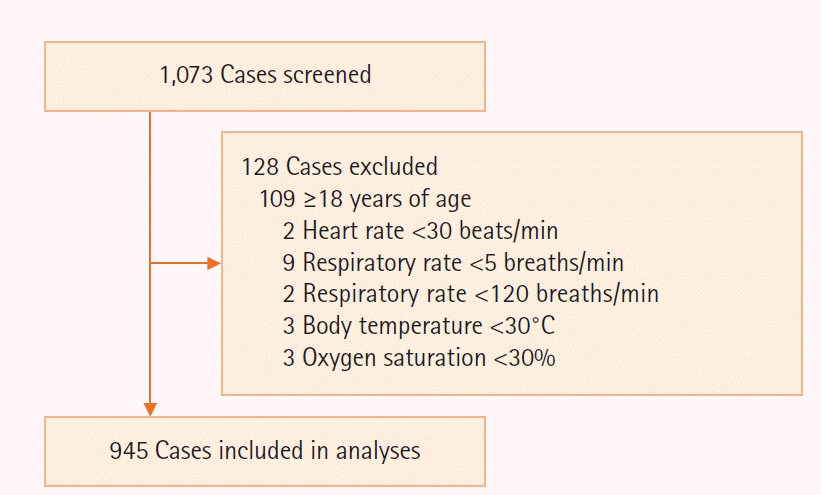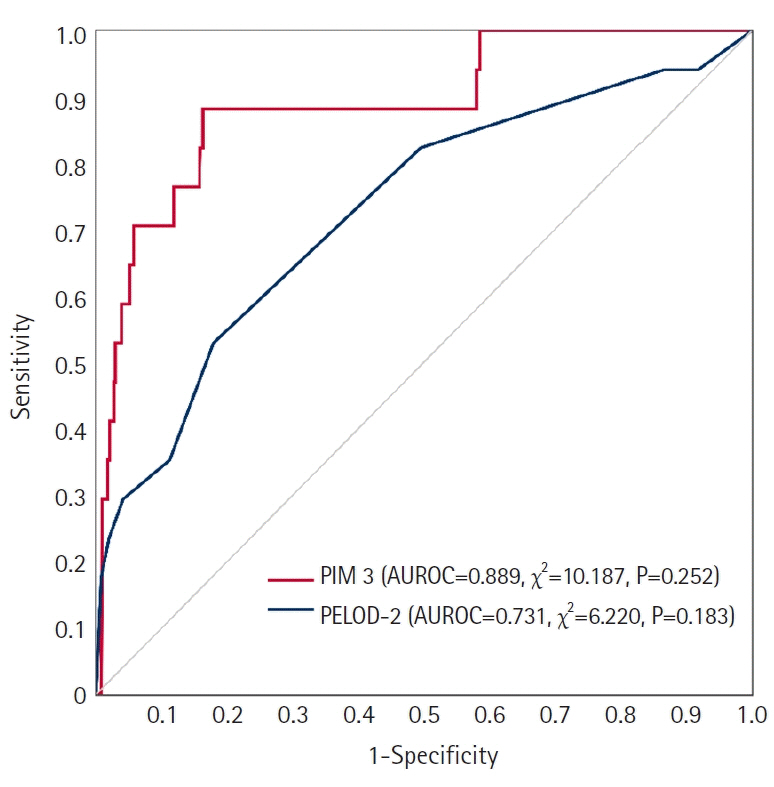Acute Crit Care.
2022 Aug;37(3):454-461. 10.4266/acc.2021.01480.
Clinical implications of discrepancies in predicting pediatric mortality between Pediatric Index of Mortality 3 and Pediatric Logistic Organ Dysfunction-2
- Affiliations
-
- 1Department of Emergency Medicine, Seoul National University College of Medicine, Seoul, Korea
- 2Department of Pediatrics, Seoul National University College of Medicine, Seoul, Korea
- 3Department of Pediatrics, National Medical Center, Seoul, Korea
- 4Department of Pediatrics, Hanyang University Medical Center, Seoul, Korea
- 5Wide River Institute of Immunology, Seoul National University, Hongcheon, Korea
- KMID: 2535309
- DOI: http://doi.org/10.4266/acc.2021.01480
Abstract
- Background
Pediatric Index of Mortality 3 (PIM 3) and Pediatric Logistic Organ Dysfunction-2 (PELOD-2) are validated tools for predicting mortality in children. Research suggests that these tools may have different predictive performance depending on patient group characteristics. Therefore, we designed this study to identify the factors that make the mortality rates predicted by the tools different.
Methods
This retrospective study included patients (<18 years) who were admitted to a pediatric intensive care unit from July 2017 to May 2019. After defining the predicted mortality of PIM 3 minus the predicted mortality rate of PELOD-2 as “difference in mortality prediction,” the clinical characteristics significantly related to this were analyzed using multivariable regression analysis. Predictive performance was analyzed through the Hosmer-Lemeshow test and area under the receiver operating characteristic curve (AUROC).
Results
In total, 945 patients (median [interquartile range] age, 3.0 [0.0–8.0] years; girls, 44.7%) were analyzed. The Hosmer-Lemeshow test revealed AUROCs of 0.889 (χ2=10.187, P=0.313) and 0.731 (χ2=6.220, P=0.183) of PIM 3 and PELOD-2, respectively. Multivariable linear regression analysis revealed that oxygen saturation, partial pressure of CO2, base excess, platelet counts, and blood urea nitrogen levels were significant factors. Patient condition-related factors such as cardiac bypass surgery, seizures, cardiomyopathy or myocarditis, necrotizing enterocolitis, cardiac arrest, leukemia or lymphoma after the first induction, bone marrow transplantation, and liver failure were significantly related (P<0.001).
Conclusions
Both tools predicted observed mortality well; however, caution is needed in interpretation as they may show different prediction results in relation to specific clinical characteristics.
Figure
Reference
-
1. Wolfler A, Osello R, Gualino J, Calderini E, Vigna G, Santuz P, et al. The importance of mortality risk assessment: validation of the Pediatric Index of Mortality 3 score. Pediatr Crit Care Med. 2016; 17:251–6.2. Seymour CW, Gesten F, Prescott HC, Friedrich ME, Iwashyna TJ, Phillips GS, et al. Time to treatment and mortality during mandated emergency care for sepsis. N Engl J Med. 2017; 376:2235–44.
Article3. Khwannimit B, Bhurayanontachai R, Vattanavanit V. Comparison of the accuracy of three early warning scores with SOFA score for predicting mortality in adult sepsis and septic shock patients admitted to intensive care unit. Heart Lung. 2019; 48:240–4.
Article4. Straney L, Clements A, Parslow RC, Pearson G, Shann F, Alexander J, et al. Paediatric index of mortality 3: an updated model for predicting mortality in pediatric intensive care. Pediatr Crit Care Med. 2013; 14:673–81.5. Leteurtre S, Duhamel A, Salleron J, Grandbastien B, Lacroix J, Leclerc F, et al. PELOD-2: an update of the PEdiatric logistic organ dysfunction score. Crit Care Med. 2013; 41:1761–73.6. Schlapbach LJ, Straney L, Bellomo R, MacLaren G, Pilcher D. Prognostic accuracy of age-adapted SOFA, SIRS, PELOD-2, and qSOFA for in-hospital mortality among children with suspected infection admitted to the intensive care unit. Intensive Care Med. 2018; 44:179–88.
Article7. El-Nawawy A, Mohsen AA, Abdel-Malik M, Taman SO. Performance of the pediatric logistic organ dysfunction (PELOD) and (PELOD-2) scores in a pediatric intensive care unit of a developing country. Eur J Pediatr. 2017; 176:849–55.
Article8. Sankar J, Gulla KM, Kumar UV, Lodha R, Kabra SK. Comparison of outcomes using Pediatric Index of Mortality (PIM) -3 and PIM-2 models in a pediatric intensive care unit. Indian Pediatr. 2018; 55:972–4.
Article9. Lee OJ, Jung M, Kim M, Yang HK, Cho J. Validation of the Pediatric Index of Mortality 3 in a single pediatric intensive care unit in Korea. J Korean Med Sci. 2017; 32:365–70.
Article10. Jacobe SJ, Hassan A, Veys P, Mok Q. Outcome of children requiring admission to an intensive care unit after bone marrow transplantation. Crit Care Med. 2003; 31:1299–305.
Article11. Russell RA, Ghanayem NS, Kuhn EM, Jeffries HE, Scanlon MC, Rice TB. Relationship between risk-adjustment tools and the pediatric logistic organ dysfunction score. World J Pediatr Congenit Heart Surg. 2014; 5:16–21.
Article12. Fleming S, Thompson M, Stevens R, Heneghan C, Plüddemann A, Maconochie I, et al. Normal ranges of heart rate and respiratory rate in children from birth to 18 years of age: a systematic review of observational studies. Lancet. 2011; 377:1011–8.
Article13. Stasinopoulos DM, Rigby RA. Generalized additive models for location scale and shape (GAMLSS) in R. J Stat Softw. 2008; 23:1–46.14. Cole TJ, Donaldson MD, Ben-Shlomo Y. SITAR: a useful instrument for growth curve analysis. Int J Epidemiol. 2010; 39:1558–66.15. Arias López MD, Boada N, Fernández A, Fernández AL, Ratto ME, Siaba Serrate A, et al. Performance of the Pediatric Index of Mortality 3 score in PICUs in Argentina: a prospective, national multicenter study. Pediatr Crit Care Med. 2018; 19:e653–61.16. Jung JH, Sol IS, Kim MJ, Kim YH, Kim KW, Sohn MH. Validation of Pediatric Index of Mortality 3 for predicting mortality among patients admitted to a pediatric intensive care unit. Acute Crit Care. 2018; 33:170–7.
Article17. Niederwanger C, Varga T, Hell T, Stuerzel D, Prem J, Gassner M, et al. Comparison of pediatric scoring systems for mortality in septic patients and the impact of missing information on their predictive power: a retrospective analysis. PeerJ. 2020; 8:e9993.
Article18. Ramazani J, Hosseini M. Comparison of the predictive ability of the pediatric risk of mortality iii, pediatric index of mortality3, and pediatric logistic organ dysfunction-2 in medical and surgical intensive care units. J Compr Ped. 2019; 10:e82830.19. Wong JJ, Hornik CP, Mok YH, Loh TF, Lee JH. Performance of the Paediatric Index of Mortality 3 and Paediatric Logistic Organ Dysfunction 2 scores in critically ill children. Ann Acad Med Singap. 2018; 47:285–90.
Article20. Gonçalves JP, Severo M, Rocha C, Jardim J, Mota T, Ribeiro A. Performance of PRISM III and PELOD-2 scores in a pediatric intensive care unit. Eur J Pediatr. 2015; 174:1305–10.
Article21. Karam O, Demaret P, Duhamel A, Shefler A, Spinella PC, Stanworth SJ, et al. Performance of the PEdiatric Logistic Organ Dysfunction-2 score in critically ill children requiring plasma transfusions. Ann Intensive Care. 2016; 6:98.
Article
- Full Text Links
- Actions
-
Cited
- CITED
-
- Close
- Share
- Similar articles
-
- Comparative validity of microalbuminuria versus clinical mortality scores to predict pediatric intensive care unit outcomes
- The Values of the Pediatric Logistic Organ Dysfunction (PELOD) Score and the Pediatric Index of Mortality (PIM) 2 Score in Emergency Department and Intensive Care Unit
- Pediatric Age-Adjusted Shock Index as a Predictor of Mortality by Sex Disparity in Pediatric Trauma: A Pan-Asian Trauma Outcome Study
- Validation of Pediatric Index of Mortality 3 for Predicting Mortality among Patients Admitted to a Pediatric Intensive Care Unit
- Prognostic factors of pediatric hematopoietic stem cell transplantation recipients admitted to the pediatric intensive care unit



